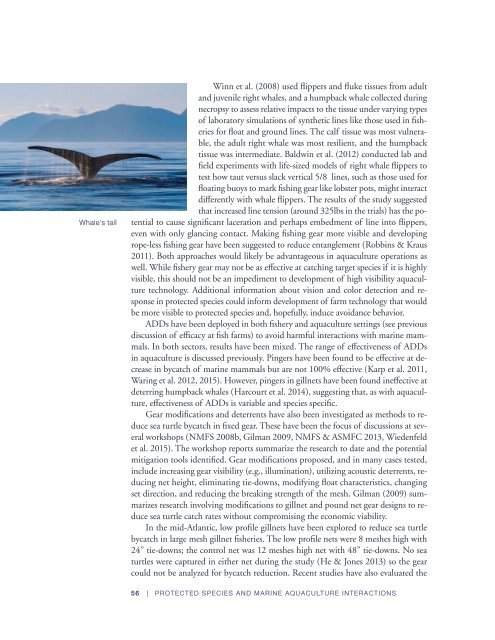Protected Species and Marine Aquaculture Interactions
x9Jh2
x9Jh2
Create successful ePaper yourself
Turn your PDF publications into a flip-book with our unique Google optimized e-Paper software.
Whale's tail<br />
Winn et al. (2008) used flippers <strong>and</strong> fluke tissues from adult<br />
<strong>and</strong> juvenile right whales, <strong>and</strong> a humpback whale collected during<br />
necropsy to assess relative impacts to the tissue under varying types<br />
of laboratory simulations of synthetic lines like those used in fisheries<br />
for float <strong>and</strong> ground lines. The calf tissue was most vulnerable,<br />
the adult right whale was most resilient, <strong>and</strong> the humpback<br />
tissue was intermediate. Baldwin et al. (2012) conducted lab <strong>and</strong><br />
field experiments with life-sized models of right whale flippers to<br />
test how taut versus slack vertical 5/8 lines, such as those used for<br />
floating buoys to mark fishing gear like lobster pots, might interact<br />
differently with whale flippers. The results of the study suggested<br />
that increased line tension (around 325lbs in the trials) has the potential<br />
to cause significant laceration <strong>and</strong> perhaps embedment of line into flippers,<br />
even with only glancing contact. Making fishing gear more visible <strong>and</strong> developing<br />
rope-less fishing gear have been suggested to reduce entanglement (Robbins & Kraus<br />
2011). Both approaches would likely be advantageous in aquaculture operations as<br />
well. While fishery gear may not be as effective at catching target species if it is highly<br />
visible, this should not be an impediment to development of high visibility aquaculture<br />
technology. Additional information about vision <strong>and</strong> color detection <strong>and</strong> response<br />
in protected species could inform development of farm technology that would<br />
be more visible to protected species <strong>and</strong>, hopefully, induce avoidance behavior.<br />
ADDs have been deployed in both fishery <strong>and</strong> aquaculture settings (see previous<br />
discussion of efficacy at fish farms) to avoid harmful interactions with marine mammals.<br />
In both sectors, results have been mixed. The range of effectiveness of ADDs<br />
in aquaculture is discussed previously. Pingers have been found to be effective at decrease<br />
in bycatch of marine mammals but are not 100% effective (Karp et al. 2011,<br />
Waring et al. 2012, 2015). However, pingers in gillnets have been found ineffective at<br />
deterring humpback whales (Harcourt et al. 2014), suggesting that, as with aquaculture,<br />
effectiveness of ADDs is variable <strong>and</strong> species specific.<br />
Gear modifications <strong>and</strong> deterrents have also been investigated as methods to reduce<br />
sea turtle bycatch in fixed gear. These have been the focus of discussions at several<br />
workshops (NMFS 2008b, Gilman 2009, NMFS & ASMFC 2013, Wiedenfeld<br />
et al. 2015). The workshop reports summarize the research to date <strong>and</strong> the potential<br />
mitigation tools identified. Gear modifications proposed, <strong>and</strong> in many cases tested,<br />
include increasing gear visibility (e.g., illumination), utilizing acoustic deterrents, reducing<br />
net height, eliminating tie-downs, modifying float characteristics, changing<br />
set direction, <strong>and</strong> reducing the breaking strength of the mesh. Gilman (2009) summarizes<br />
research involving modifications to gillnet <strong>and</strong> pound net gear designs to reduce<br />
sea turtle catch rates without compromising the economic viability.<br />
In the mid-Atlantic, low profile gillnets have been explored to reduce sea turtle<br />
bycatch in large mesh gillnet fisheries. The low profile nets were 8 meshes high with<br />
24” tie-downs; the control net was 12 meshes high net with 48” tie-downs. No sea<br />
turtles were captured in either net during the study (He & Jones 2013) so the gear<br />
could not be analyzed for bycatch reduction. Recent studies have also evaluated the<br />
56 | ProtEctEd SPEciES <strong>and</strong> MarinE aquaculturE intEractionS


